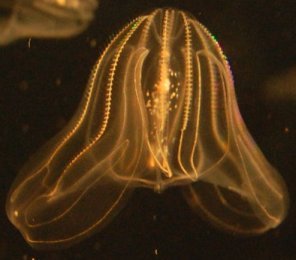Another Evolutionary Prediction Falsified
Mnemiopsis leidyi, a species of comb jelly
(click for credit)
The animal pictured above is Mnemiopsis leidyi, a species of comb jelly. According to evolutionary theory, the comb jellies are “primitive.” Based on genetics, they are supposed to have evolved before some of the simplest animals on the planet: sponges. Even if you don’t believe the genetic arguments, most evolutionists would agree that comb jellies evolved well before the more “advanced” animals, such as roundworms.
One of the things that separates these “primitive” animals from the more “advanced” animals is their digestive tract. In animals like jellyfish and sponges, there is only one opening in the digestive tract. The animal must use that opening to take in food, and then later it must use the same opening to expel indigestible waste. According to the story of evolution, this “simple” digestive tract was the first to evolve, and then later, a more “advanced” digestive tract formed. In this more “advanced” digestive tract, there is one opening for taking in food and a different opening for expelling indigestible waste.
Since comb jellies are suppose to be among the “primitive” animals, evolution predicts that they should have “simple” digestive tracts. However, recent videos demonstrate that this evolutionary prediction is (not surprisingly) wrong.
Comb jellies are part of phylum Ctenophora, and some of the biologists who study them recently attended a convention that is appropriately named Ctenopalooza. One of the speakers at that convention was Dr. William Browne. During a presentation, he showed two videos of two different comb jellies: Mnemiopsis leidyi (shown in the picture above) and Pleurobrachia bachei. According to one report, the videos “elicited gasps from the audience,” because they showed the comb jellies taking in food through one opening, and then expelling indigestible waste from a completely different opening.
In other words, these videos showed that at least two species of comb jellies don’t have “simple” digestive tracts. Instead, they have digestive tracts that are supposed to be characteristic of “more advanced” animals, like roundworms. It’s not surprising that this revelation elicited gasps from the audience, because the majority of those in attendance no doubt think that evolution is a good scientific theory. Thus, they are inclined to believe the predictions of evolution, and evolution clearly predicts that comb jellies should have “simple” digestive tracts.
Now please understand that to true believers, the fact that yet another evolutionary prediction has been falsified isn’t a big deal. Indeed, the same report that described the audience’s reaction at Ctenopalooza already started trying to explain around this falsified prediction. It’s possible, the report suggests, that comb jellies evolved an “advanced” digestive tract independently of the other animals that have it. While adding such an epicycle forces evolutionary theory to be consistent with the known data, it doesn’t erase the fact that this is yet another example of a failed evolutionary prediction.
Jay L. Wile's Blog
- Jay L. Wile's profile
- 31 followers




